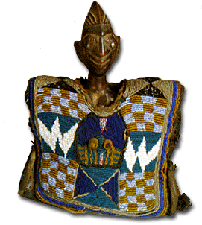| Ire Ibejis
Despite the fact that Ire Ibejis serve as a receptacle or dwelling
place for the spirit of a dead child, these carvings don't look anything
like children. The figures are carved to represent an ideal physical
type represented by the Yoruba people. From
the Ire Ibeji featured here we can see the Yoruba idea of beauty is
one that shows the figure in the prime of life - neither a child nor
an old person. The Ire Ibeji style emphasizes:
|







